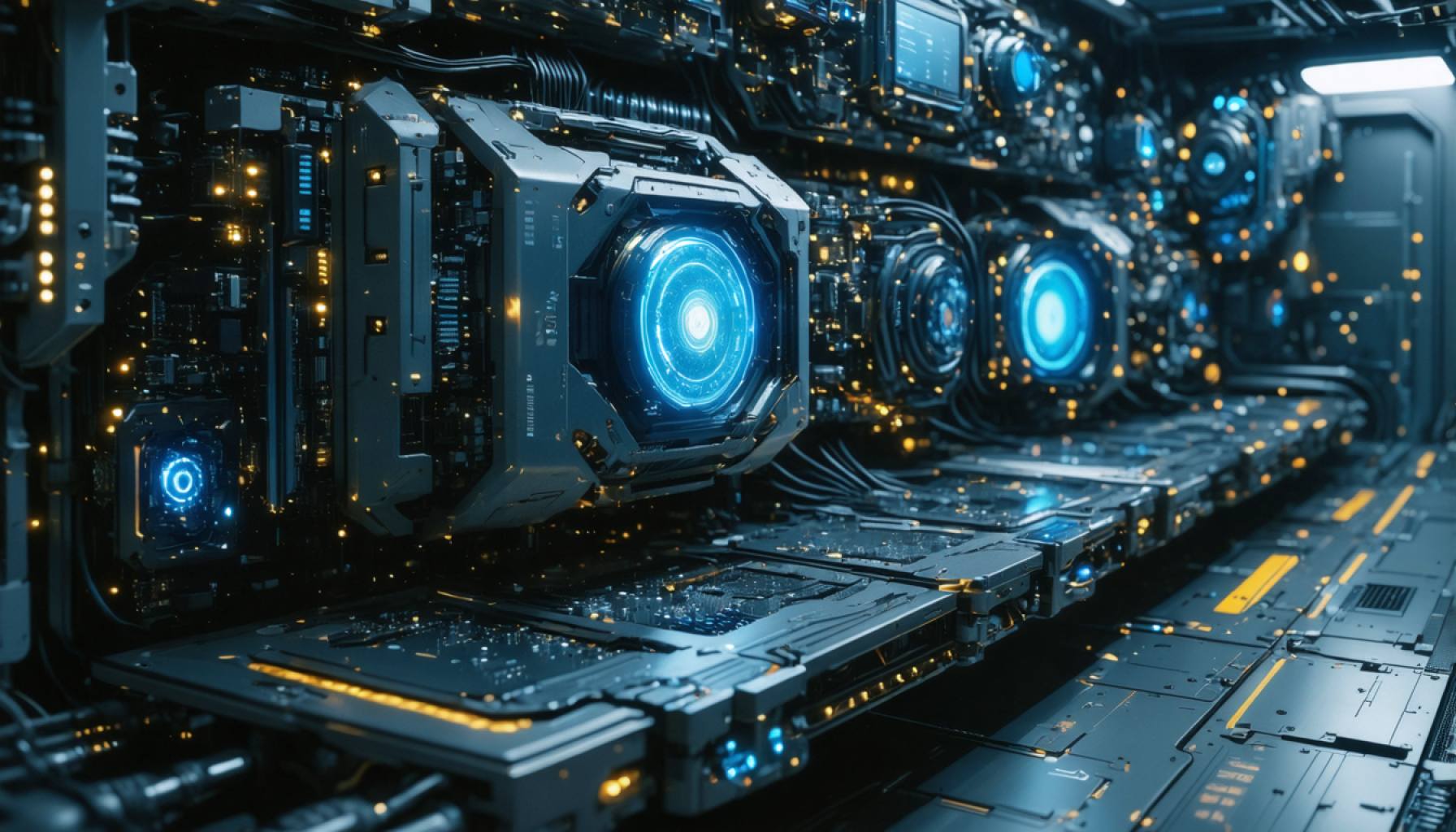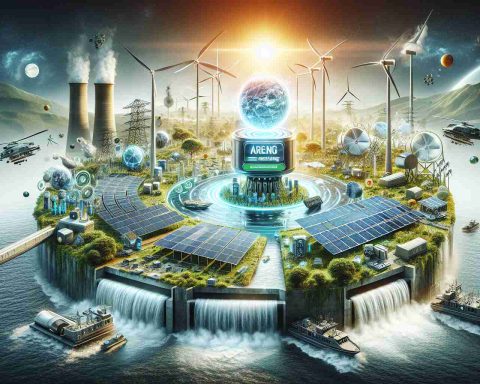- Nvidia’s GPUs are at the forefront of AI advancement, powering innovative projects and driving technological evolution.
- Project Stargate, a $100 billion initiative, will feature 64,000 Nvidia GPUs across ten data centers, with the first 16,000 operational by this summer.
- Collaborative partners like Oracle, OpenAI, and Softbank are involved, emphasizing the project’s massive scale and significance.
- Nvidia’s cutting-edge hardware aligns with AI demands, enhancing its standing and revolutionizing technology interaction.
- Despite recent stock declines, analysts predict Nvidia’s strong recovery with anticipated earnings growth.
- Project Stargate represents a commitment to AI infrastructure, innovation, and societal integration, highlighting the transformative power of Nvidia’s GPUs.
Amid the rapidly swirling eddies of technological advancement, there’s a name that shines brightly: Nvidia. As AI continues to reshape industries and redefine possibilities, Nvidia’s graphics processing units (GPUs) stand at the forefront, powering revolutionary projects and fueling the imagination of innovators worldwide.
Picture this: a sprawling data center in the heart of Texas, a digital oasis emerging from the grit and heat of the Lone Star State. By December 2026, 64,000 Nvidia GPUs are poised to light up its corridors, forming the beating heart of Project Stargate — a colossal AI infrastructure endeavor that promises to carve a new path in the realm of artificial intelligence.
This initiative, with a staggering commitment of $100 billion, is not a solitary journey. Oracle, OpenAI, and Softbank have collectively rolled up their sleeves to bring this venture to life. Expectations resonate through the tech community like seismic tremors, as Project Stargate was unveiled with much fanfare at the White House, setting the stage for a digital revolution across potentially ten data centers.
Nvidia, no stranger to transformative technology, finds itself a cornerstone of this ambitious endeavor. The company’s GPUs, renowned for their prowess in training AI models, are set to scale unprecedented heights. By this summer alone, 16,000 of these computational powerhouses will spring into action, turbocharging the data center’s capabilities and signaling a bold new era for AI infrastructure.
But why Nvidia? The answer lies in the symbiotic relationship between Nvidia’s cutting-edge hardware and the escalating demands of AI innovation. This alignment promises not only to elevate Nvidia’s standing but also to revolutionize the way we perceive and interact with technology.
Investors are keeping a keen eye on NVIDIA’s trajectory. Despite a rocky economic climate with the stock facing dips — down 18% this year — analysts foresee a robust recovery with earnings per share projected to surge.
As the dust settles on this monumental endeavor, the takeaway is clear. Project Stargate embodies more than just an investment in infrastructure; it symbolizes a commitment to pushing boundaries and embracing a future where AI is interwoven into the very fabric of society. Nvidia’s GPUs are not just components; they are the catalysts of change, stitching together the visionaries’ dreams with tangible realities.
In this era of rapid transformation, Nvidia’s story is one of ambition, collaboration, and innovation. It’s an exhilarating chapter in the book of technological evolution, inviting us all to witness the dawn of possibilities as GPUs power forward into the future.
Nvidia’s Next Leap: How GPUs are Shaping the AI Universe
Nvidia’s Role in the AI Revolution
Nvidia has long been a beacon in the tech world, particularly in AI and machine learning, thanks to their industry-leading graphics processing units (GPUs). As artificial intelligence continues to play a crucial role in reshaping industries, Nvidia’s GPUs are transforming into the backbone of innovative projects like Project Stargate. This massive AI infrastructure effort aims to harness Nvidia’s powerful technology to revolutionize several sectors.
How Nvidia GPUs Catalyze AI Advancements
1. Performance and Scalability: Nvidia GPUs are engineered to handle thousands of simultaneous computations, making them ideal for AI model training, which involves processing vast datasets efficiently. This capability enhances the scalability of AI solutions, enabling the development of more sophisticated models.
2. Energy Efficiency: Despite their high performance, Nvidia GPUs are designed with energy efficiency in mind. This is critical in large-scale data centers where power consumption is a significant concern. By reducing energy use, Nvidia contributes to the sustainability of advanced AI projects.
3. Versatility: Nvidia GPUs are not limited to just AI applications. They also support a wide range of tasks, from scientific computations to graphics rendering, making them versatile tools in various industries.
Real-World Use Cases of Nvidia GPUs
– Healthcare: AI models powered by Nvidia GPUs are used in drug discovery and medical imaging, allowing for faster and more accurate diagnoses.
– Autonomous Vehicles: Nvidia’s GPUs are the driving force behind the AI systems in autonomous vehicles, processing data from cameras and sensors to navigate safely.
– Financial Services: In finance, Nvidia GPUs facilitate high-frequency trading and risk management through the rapid analysis of complex data.
Industry Trends and Market Forecasts
Nvidia’s position in the AI industry remains strong, with continuous demand for their GPUs anticipated. According to market research, the global GPU market is expected to grow at a compound annual growth rate (CAGR) of over 12% by 2028. This growth is fueled by the increased integration of AI across industries and Nvidia’s continuous innovation.
FAQs: Answering Your Burning Questions
Why is Nvidia a preferred choice for AI projects?
Nvidia’s GPUs are renowned for their parallel processing capabilities, high efficiency, and adaptability, making them ideal for complex AI computations.
What is Project Stargate, and why is it significant?
Project Stargate is a large-scale AI infrastructure project involving 64,000 Nvidia GPUs, intended to push the boundaries of AI capabilities and infrastructure.
How does Nvidia ensure the sustainability of its GPUs?
Nvidia focuses on reducing the energy consumption of its GPUs through innovative designs, which is crucial for the sustainability of large data operations.
Pros and Cons of Nvidia GPUs
Pros:
– Unmatched processing power
– Energy efficiency
– Versatility across industries
Cons:
– Initial investment cost
– Continuous need for updates and maintenance
Conclusion: Actionable Recommendations
For enterprises looking to leverage AI technologies, investing in Nvidia GPUs offers a robust platform to develop advanced AI solutions. Assess your specific computational needs and consider Nvidia’s product lineup for an optimal fit.
Stay informed about Nvidia’s latest advancements and collaborations by visiting their official website: Nvidia. Keep an eye on market trends and technological developments to harness the full potential of GPUs in AI-driven innovation.







